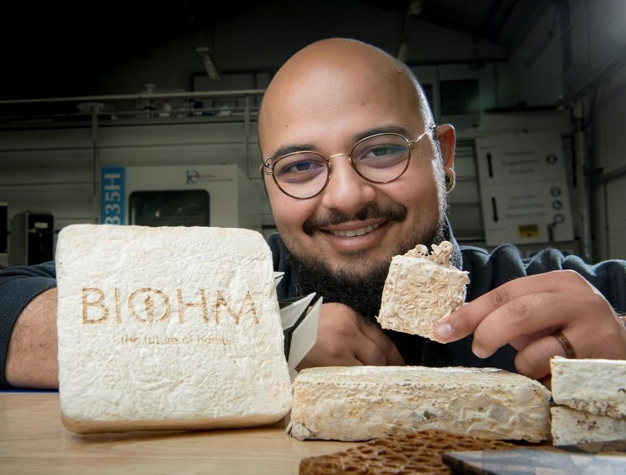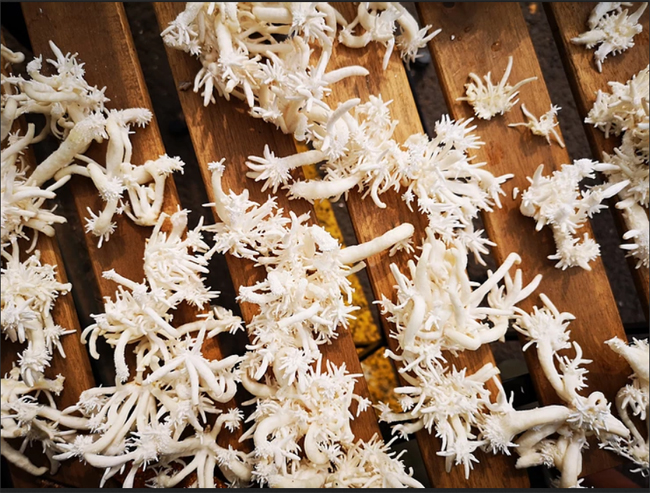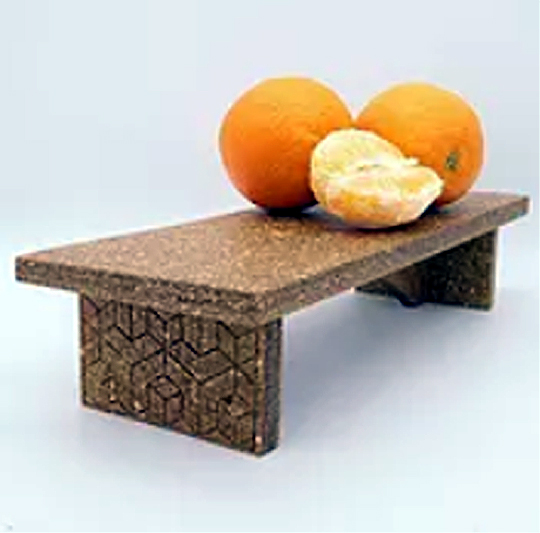|
|

|
  
Features
Update 2021/3/31
Renewables
INSPIRED BY NATURE, START-UP BIOHM
IS REVOLUTIONIZING OUR BUILT ENVIRONMENT
By Suzanne Forcese
“If we are to venture beyond merely reducing our impact on the planet and our health; contemporary approaches to waste management, manufacturing and building must undergo a step-change towards having a positive and regenerative impact.”Ehab Sayed, Founder of BIOHM
BIOHM, a multi-award-winning research and development led UK start-up company aims to revolutionize the construction industry with its bio-based materials.
WATERTODAY reached out to Ehab Sayed, Founder and CEO of BIOHM for a conversation on the topic of biomimetics (biomimicry) solutions.
One of BIOHM’s products that is poised to disrupt the built environment is insulation panels – made from plastic-eating mushrooms.
“We harness the power of mycelium – the root structure of mushrooms,” Sayed said. “We are working with over 300 species of mycelium. We train them to consume anything from food waste, construction waste, fashion waste.
“Even plastic.”
If we all stopped using plastic today, there would still be over 269,000 tonnes of plastic waste – in the oceans alone-- to clean up. That does not even take into consideration the countless microplastics that have made their way into our drinking water, food, and air.
“The natural world has developed a more elegant solution. Or more specifically the microbial world has. Fungi are the least picky eaters of any microbiome.”

Ehab Sayed, Founder and Director of Innovation at BIOHM and PhD Researcher at Northumbria
University, is a sustainable designer, engineer, circular economy strategist and built environment innovator with a passion for creating a biomimetic (nature inspired) circular future that meets our environmental, human and economic needs.
Sayed adds the mycelium's appetite for plastic was discovered in the London lab when one of the species of mycelium was making a freedom dash from its test tube. It was eating its way through the plastic sponge seal on its container.

To grow mycelium, BIOHM identifies commercial and agricultural by-products that would otherwise go to landfill. Evolving from eating leaf matter to eating plastic might seem like a huge jump – something that might take millennia for humans to evolve to through natural selection, but for fungi it’s a piece of cake.
“When it came to investigating insulation, we wanted to look for examples in Nature. Structures that are naturally grown and are naturally created to achieve the highest level of porosity.
“Our mycelium insulation is demonstrating unbeatable performance properties. It’s fire resistant. It’s outperforming leading building insulation products offering advanced levels of thermal and acoustic insulation and creates healthy breathable homes.”
ORB (Organic Refuse Biocompound) is another material BIOHM has developed which does not use or contain any synthetic chemicals or additives. It is 100% natural, biodegradable, regenerative and circular.
“We source waste by-product from the food production or agricultural sectors and bind it together with our unique organic binder forming an affordable and sustainable alternative for wood-based, formaldehyde-based or polymer-based sheet materials.
“At the end of the material’s life it can either be fed back into its manufacturing process or cold-composted.”

A prime example of ORB is the development of orange peel. The process involves activating the natural plasticizers present in the peel.
BIOHM is also developing ORB into a Plant-Based concrete and exploring biologically self-assembling homes in a revolutionary construction system.
Triagomy consists of interlocking building blocks that do not require any permanent binders or fasteners to create robust buildings, offering architects near limitless flexibility.
The system allows buildings to be reconfigured or deconstructed at any stage of their life – meaning homes can shrink or grow in accordance with need. Triagomy reduces a buildings environmental impact by up to 120%; build times by around 95%; and costs by up to 70% when compared to traditional building methods.
“We truly appreciate nature’s genius and place biological systems at the heart of our inspiration to revolutionize our built environment and the way we do business. We have developed circular business models that inspire sustainable consumption habits, disrupt property markets, reimagine our financial ecosystems and champion the circular economy.”
As BIOHM is now focusing on commercialization, the goal is to scale up material production facilities to cope with the ever-growing demand of bio-based materials.
“Each bio-manufacturing facility we set up will provide enough material for up to 120 homes per month. This means that every month, the production of our materials in one small facility can use up over 150 tonnes of waste, storing a minimum of 16 tonnes of carbon as they grow.”
BIOHM’s international team aims to grow the company in an ethically sound fashion.
“We are setting up the world’s first community led bio- manufacturing facilities in collaboration with social enterprises aimed at enriching and regenerating local communities through the equitable distribution of benefits. Also, we are working closely with the world’s largest corporations, the world’s top universities, and the world’s most prominent governments... and of course local communities, local resources, local businesses.
“Globally it’s time for a new economy. An economy that is governed by nature and driven by global needs. An economy that values all life forms.”
“We are living through a very interesting time, where for the first time in modern history the world, as we know it, has come to a standstill. The pandemic has revealed multiple flaws in our current systems. How far removed have we become from the natural world? In Nature everything is in constant flow, constant circulation with outputs from one process becoming the inputs for others.
“Left to its own devices nature manages resources in a highly efficient and balanced manner and that is exactly what we do at BIOHM.”
BIOHM
OHM – noun(om/aum) A sacred mantra, the vibration of everything in the universe.
OM - noun The standard unit of electrical resistance.
BIO -bio-based: Bio-mimetic;Bio-Revolution
The Future Of Home
suzanne.f@watertoday.ca
|
|
|
Have a question? Give us a call 613-501-0175
All rights reserved 2025 - WATERTODAY - This material may not be reproduced in whole or in part and may not be distributed,
publicly performed, proxy cached or otherwise used, except with express permission.
|
| |